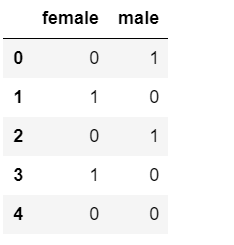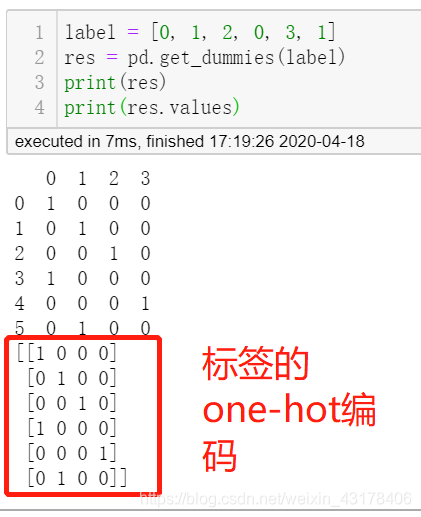1. 基本概念
1. 1 语料库&词典
- 一般语料库就是很多篇文章(可能一篇文章有好几句话,也可能只有一句话),在实际业务中,每篇文章一般要先进行分词
- 词典:语料库中词的种类数,即有多少个词,一般用|V|表示
- 树中根节点就是最上面那个,叶子结点就是结果(如分类的标签),结点泛指所有(包括根节点、叶子结点)
2. 词向量:one-hot & 特征、标签的ont-hot编码
2.1 词向量one-hot
对于训练数据,如
[[the, cat, is, running],
[the, dog, is, cute, that, dog, is, smart]]
one_hot就是词出现一次就打上标签1。上述训练数据转换之后为

可以看到最上面一行就是词的种类,第二行是第一个样本的one-hot转换,第三行是第二个样本的ont-hot转换。只要出现了该词,就打1,无论出现了多少次。
ont-hot首先没考虑词的顺序,也没考虑词出现的次数。且容易造成很大的稀疏矩阵。
- one-hot代码实现
from sklearn.feature_extraction.text import CountVectorizer
corpus = [
'This is the first document.', # 输入的文本是一个字符串
'This document is the second document.',
'And this is the third one.',
'Is this the first document?']
vectorizer = CountVectorizer(binary=True) # 注这里binary一定为True,否则就不是one-hot了
X = vectorizer.fit_transform(corpus)
print(vectorizer.get_feature_names())
print(X.toarray())
['and', 'document', 'first', 'is', 'one', 'second', 'the', 'third', 'this']
[[0 1 1 1 0 0 1 0 1]
[0 1 0 1 0 1 1 0 1]
[1 0 0 1 1 0 1 1 1]
[0 1 1 1 0 0 1 0 1]]
2.2 特征、标签的ont-hot编码
- 除了上述将整个文本用one-hot表示,机器学习中还会遇到将类别特征进行ont-hot编码。如多元线性回归中,其中一个特征是性别(男,女),这时,我们就想让男、女各单独作为一个特征,如果是男,男的特征就为1,相应的女的特征就为0。具体实现如下
# sklearn 实现---1
# sklearn中OneHotEncoder可以同时对多列特征就行one-hot处理
from sklearn.preprocessing import OneHotEncoder
enc = OneHotEncoder(handle_unknown='ignore')
X = [['Male', 'a', 'c'],
['Female', 'b', 'd'],
['Female', 'c', 'e']]
enc.fit(X) # 第一列是性别特征,可以分成两列,分别代表是不是男,是不是女;其他两列亦同。
print(enc.categories_)
enc.transform([['Female', 1, 2],
['Male', 'e', 'e']]).toarray() # 当transform出现训练集没有的,如本来是男女,突然出现一个“unknown”,这时男、女两列都为0,因为handle_unknown='ignore',还可以设置成’error’
# 即出现训练集没有的就报错
[array(['Female', 'Male'], dtype=object), array(['a', 'b', 'c'], dtype=object), array(['c', 'd', 'e'], dtype=object)]
array([[1., 0., 0., 0., 0., 0., 0., 0.],
[0., 1., 0., 0., 0., 0., 0., 1.]])
# pandas实现
s = pd.Series(['male', 'female', 'male', 'female', np.nan])
pd.get_dummies(s)

上面pandas实现的时候是以特征性别为例的,如果换成标签,就是对标签进行one-hot编码

标签的one-hot编码,pytorch、tensorflow(包括keras)都实现了自己的api,在此不再赘述。
3. 词向量:词袋
上一章one-hot词向量不考虑单词出现的次数,如
[[the, cat, is, running],
[the, dog, is, cute, that, dog, is, smart]]
虽然第二句话,the出现了两次,但最终the仍表示成1。
词袋就是在one-hot基础上发展而来的,只是不再仅仅表示成1,而是单词出现的个数。此时该例的结果为

- 代码实现
from sklearn.feature_extraction.text import CountVectorizer
corpus = [
'the cat is running',
'this dog is cute that dog is smart']
vectorizer = CountVectorizer(binary=False) # binary改为False就是统计出现的次数,即词袋了
X = vectorizer.fit_transform(corpus)
print(vectorizer.get_feature_names())
print(X.toarray())
['cat', 'cute', 'dog', 'is', 'running', 'smart', 'that', 'the', 'this']
[[1 0 0 1 1 0 0 1 0]
[0 1 2 2 0 1 1 0 1]]
4. 词向量:n-gram & 语言模型:n-gram
4.1 词向量
还是该例
[[the, cat, is, running],
[this, dog, is, cute, that, dog, is, smart]]
上两章都是以一个单词为单元统计是否出现或出现的次数,但有时两个单词可能更有意义,如do not,统计do not出现的次数更加符合实际,这就是n-gram词向量表示。下面从代码中具体理解,依然用的是sklearn的CountVectorizer这个API
from sklearn.feature_extraction.text import CountVectorizer
corpus = ['the cat is running',
'this dog is cute, that dog is smart']
vectorizer = CountVectorizer(ngram_range=(1,2)) # (1,2)表示统计单个词出现的次数及两个词一起出现的次数
X = vectorizer.fit_transform(corpus)
print(vectorizer.get_feature_names())
print(X.toarray())
['cat', 'cat is', 'cute', 'cute that', 'dog', 'dog is', 'is', 'is cute', 'is running', 'is smart', 'running', 'smart', 'that', 'that dog', 'the', 'the cat', 'this', 'this dog']
[[1 1 0 0 0 0 1 0 1 0 1 0 0 0 1 1 0 0]
[0 0 1 1 2 2 2 1 0 1 0 1 1 1 0 0 1 1]]
4.2 sklearn.feature_extraction.text.CountVectorizer讲解
one-hot向量、词袋向量、n-gram向量都是用的该API,下面就对该API详细介绍一下

蓝色填充表示比较重要。其中,重音可参考https://zimt8.com/questions/517923/
from sklearn.feature_extraction.text import CountVectorizer
corpus = [
'a fine cut',
'他 喜欢 动物']
vectorizer = CountVectorizer(binary=False, analyzer='word', )
X = vectorizer.fit_transform(corpus)
print(vectorizer.get_feature_names())
print(X.toarray())
['cut', 'fine', '动物', '喜欢']
[[1 1 0 0]
[0 0 1 1]]
从结果我们可以看到,在生成的词典里没有a、他。原因如下:
没有指定vocabulary,即生成的词典需要CountVectorizer根据分词结果及max_df、max_features等自己生成;此外没有指定tokenizer,及分词函数没有指定;在上述两个参数都没指定的情况下,就会看参数token_pattern,而我们又没有指定,那么CountVectorizer就会以单个字母或汉字及各种标点符号当做分词的标准。所以上述代码没有a和他。如果想让a和他也加入到生成的词典中,有三种方法
- 指定vocabulary,此时tokenizer/token_pattern/stop_words/max_df等都无效,即和分词有关的参数都无效。可以看到最终生成的词典只有我们参数中指定的a/他/喜欢

- 在不指定vocabulary的情况下,指定tokenizer,即指定分词的函数,此时stop_words等还是有效的,因为我们指定这个参数,仅仅是确定如何分词,不影响最终生成的词典还需要去停用词,去不满足max_features等的词,但是token_pattern无效

- 在不指定vocabulary和tokenizer的情况下,指定token_pattern,该参数和tokenizer相似,指定了要保留哪些词,需要用正则表达式。

4.3 语言模型:n-gram
在讲n-gram之前,首先了解什么是朴素贝叶斯,而朴素贝叶斯模型和n-gram模型都属于语言模型的一种
4.3.1 语言模型
语言模型就是计算一个句子的概率模型。比如以下两句话
今天天气很好,我们出去玩吧。
今天天气很好,俺们出去玩吧。
如果第一句话出现的概率为80%,第二句话出现的概率为60%,那么我们认为第一句话更为合理。
如何计算一句话出现的概率?
假如计算"我爱你"这句话出现的概率
令s=“我爱你”
那么
p ( s ) = p ( 我 ) p ( 爱 ∣ 我 ) p ( 你 ∣ 我 爱 ) p(s)=p(我)p(爱|我)p(你|我爱) p(s)=p(我)p(爱∣我)p(你∣我爱)
一般得,一句话 s = ( ω 1 , ω 2 , . . . , ω n ) s=(\omega_1, \omega_2,...,\omega_n) s=(ω1,ω2,...,ωn)出现的概率为:
p ( s ) = p ( ω 1 ) p ( ω 2 ∣ ω 1 ) p ( ω 3 ∣ ω 1 , ω 2 ) . . . p ( ω n ∣ ω 1 , ω 2 , . . . , ω n − 1 ) p(s) = p(\omega_1)p(\omega_2|\omega_1)p(\omega_3|\omega_1,\omega_2)...p(\omega_n|\omega_1,\omega_2,...,\omega_{n-1}) p(s)=p(ω1)p(ω2∣ω1)p(ω3∣ω1,ω2)...p(ωn∣ω1,ω2,...,ωn−1)
语言模型的缺点:
- 参数空间过大,条件概率 p ( ω n ∣ ω 1 , ω 2 , . . . , ω n − 1 ) p(\omega_n|\omega_1,\omega_2,...,\omega_{n-1}) p(ωn∣ω1,ω2,...,ωn−1)d的可能性太多,无法估算
- 数据稀疏严重,对于非常多词的组合,在语料库中都没有出现,依据最大似然估计得到的概率将为0
4.3.2 n-gram
上一小节提到参数空间过大的问题,因此引入一个假设:任意一个词出现的概率只与它前面出现的有限的一个或几个词有关。
假设一个词出现的概率只有他前面的一个词有关,这种假设被称为马尔科夫假设。此时S的概率变为
p ( ω 1 , . . . ω n ) = p ( ω 1 ) p ( ω 2 ∣ ω 1 ) p ( ω 3 ∣ ω 2 ) . . . p ( ω n ∣ ω n − 1 ) p(\omega_1,...\omega_n)=p(\omega_1)p(\omega_2|\omega_1)p(\omega_3|\omega_2)...p(\omega_n|\omega_{n-1}) p(ω1,...ωn)=p(ω1)p(ω2∣ω1)p(ω3∣ω2)...p(ωn∣ωn−1)
接下来的问题变成估计条件概率 p ( ω i ∣ ω i − 1 ) p(\omega_i|\omega_{i-1}) p(ωi∣ωi−1):
p ( ω i ∣ ω i − 1 ) = p ( ω i , ω i − 1 ) p ( ω i − 1 ) p(\omega_i|\omega_{i-1})=\frac{p(\omega_i, \omega_{i-1})}{p(\omega_{i-1})} p(ωi∣ωi−1)=p(ωi−1)p(ωi,ωi−1)
当样本量很大时,基于大数定律,一个短语或者词语出现的概率可以用其频率来表示,即:
p ( ω i ∣ ω i − 1 ) = c o u n t ( ω i , ω i − 1 ) c o u n t ( ω i − 1 ) p(\omega_i|\omega_{i-1})=\frac{count(\omega_i, \omega_{i-1})}{count(\omega_{i-1})} p(ωi∣ωi−1)=count(ωi−1)count(ωi,ωi−1)
举个例子,假设语料库词语出现的次数如下表所示:

对于第二个表格,其意义是竖列中的单词出现后,横列单词出现的次数。那么如何从语料库得到上述表格?一般语料库是很多篇文档(个人认为如果一篇文档也很多句话,那么可以将每句话都当成一个独立的文档,后续所说文档指的是文档中的每句话),首先将文档进行分词。最终是类列表的结构,比如
[[the, cat, is, running],
[the, dog, is, cute, that, dog, is, smart]]
然后根据前面讲到的词袋进行统计单个单词出现的次数,两个单词出现的次数
现在假如我们现在要计算p(want|i):
p ( w a n t ∣ i ) = c o u n t ( i , w a n t ) c o u n t ( i ) = 827 2533 = 0.33 p(want|i)=\frac{count(i,want)}{count(i)}=\frac{827}{2533}=0.33 p(want∣i)=count(i)count(i,want)=2533827=0.33
对于一句话s = “I want food”,其计算公式为:
p ( s ) = p ( I ) p ( w a n t ∣ I ) p ( f o o d ∣ w a n t ) p(s)=p(I)p(want|I)p(food|want) p(s)=p(I)p(want∣I)p(food∣want)
一般地,对于首个单词的概率p(I)我们认为 p ( I ) = p ( I ∣ < s > ) p(I)=p(I|<s>) p(I)=p(I∣<s>),其中 < s > <s> <s>表示一篇文章的开始,此外 < e > <e> <e>表示一篇文章的结束。因此 p ( s ) = p ( I ∣ < s > ) p ( w a n t ∣ I ) p ( f o o d ∣ w a n t ) p ( < e > ∣ f o o d ) p(s)=p(I|<s>)p(want|I)p(food|want)p(<e>|food) p(s)=p(I∣<s>)p(want∣I)p(food∣want)p(<e>∣food)
对于 p ( I ) = p ( I ∣ < s > ) p(I)=p(I|<s>) p(I)=p(I∣<s>),上表中没有体现,现假设我们有10000篇文章,其中5000个文章的首个单词(除了 < s > <s> <s>)都是以I开头的,那么 p ( I ) = p ( I ∣ < s > ) = 5000 10000 = 0.5 p(I)=p(I|<s>)=\frac{5000}{10000}=0.5 p(I)=p(I∣<s>)=100005000=0.5
对于 p ( w a n t ∣ I ) 、 p ( f o o d ∣ w a n t ) p(want|I)、p(food|want) p(want∣I)、p(food∣want)在表格中有体现,分别为0.33和0.0065。
对于 p ( < e > ∣ f o o d ) p(<e>|food) p(<e>∣food)在表格中也没有体现,假设我们10000篇文章中有100篇是以food结尾的,那么 p ( < e > ∣ f o o d ) = 100 10000 = 0.01 p(<e>|food)=\frac{100}{10000}=0.01 p(<e>∣food)=10000100=0.01
因此,最终:
p ( s ) = p ( I ∣ < s > ) p ( w a n t ∣ I ) p ( f o o d ∣ w a n t ) p ( < e > ∣ f o o d ) = 0.5 ∗ 0.33 ∗ 0.0065 ∗ 0.01 = 1.0725 e − 5 p(s)=p(I|<s>)p(want|I)p(food|want)p(<e>|food)=0.5*0.33*0.0065*0.01=1.0725e-5 p(s)=p(I∣<s>)p(want∣I)p(food∣want)p(<e>∣food)=0.5∗0.33∗0.0065∗0.01=1.0725e−5
如果一个词的出现与它周围的词是独立的,称为一元语言模型(unigram);
如果一个词的出现仅依赖于它前面的一个词,称为二元语言模型(bigram);
如果一个词的出现依赖于它前面的两个词,称为三元语言模型(trigram);
其他的以此类推
下表是各种语言模型的参数量:

由此可见当n很大时,参数量也是很大的,一般我们用2-3即可。
关于语言模型的代码好像还没有进行封装,因此我们可以根据上述的CountVectorizer等自己写代码计算。语言模型更多的是理论,作为后续推出的各种模型的基础,如nnlm。

4.3.3 朴素贝叶斯模型&n-gram模型
上一小节讲到了n-gram,此n-garm是语言模型的一种假设,本小节所述n-garm以及贝叶斯是一种分类模型,具体详见博客https://blog.csdn.net/weixin_43178406/article/details/105702387
5. 词向量tf-idf
给定训练语料(corpus),如
[[the, cat, is, running],
[this, dog, is, cute, that, dog, is, smart]]
假如我们最终的词典为[‘cat’, ‘cute’, ‘dog’, ‘is’, ‘running’, ‘smart’, ‘that’, ‘the’, ‘this’]
那么the这个词经过tf-idf处理,就会得到一个对应的数字,词典中其他单词亦同。
那么这个数字是如何得到的?
tf-idf = tf × idf
- 计算tf值,tf值就是词频,表示一个给定词语t在一篇给定文档d中出现的频率,即单词t出现的次数除以当前文档中词出现的总次数。tf越高,则词语t对文档d来说越重要,TF越低,则词语t对文档d来说越不重要。
- 计算idf值:逆文档频率。tf值很高,并不能说明该词对文章的贡献度高,比如单词is在所有文章中出现的次数都很高,其tf值甚至高于关键词如doctor,但is并不是我们想要的(doctor才是)。所以此时需要计算一个逆文档频率。如is所有文档中出现次数都很高,那么出现该词的文章数除以所有文章数就越大,其倒数越小。因此用 l o g 总 文 章 数 出 现 单 词 t 的 文 章 数 log\frac{总文章数}{出现单词t的文章数} log出现单词t的文章数总文章数来限制tf
- 实际应用中,idf需要进行平滑处理,因为除数为0,就无法计算了。常用的平滑方法如下:
l o g 总 文 章 数 + 1 出 现 单 词 t 的 文 章 数 + 1 + 1 log\frac{总文章数+1}{出现单词t的文章数+1}+1 log出现单词t的文章数+1总文章数+1+1
l o g 总 文 章 数 出 现 单 词 t 的 文 章 数 + 1 log\frac{总文章数}{出现单词t的文章数+1} log出现单词t的文章数+1总文章数
- 实例代码
# 使用sklearn中的TfidfVectorizor
from sklearn.feature_extraction.text import TfidfVectorizer
corpus = ['the cat is running',
'this dog is cute, that dog is smart']
vectorizer = TfidfVectorizer()
X = vectorizer.fit_transform(corpus)
print(vectorizer.get_feature_names())
print(X.toarray())
['cat', 'cute', 'dog', 'is', 'running', 'smart', 'that', 'the', 'this']
[[0.53404633 0. 0. 0.37997836 0.53404633 0.
0. 0.53404633 0. ]
[0. 0.3158336 0.6316672 0.44943642 0. 0.3158336
0.3158336 0. 0.3158336 ]]
# 使用sklearn中的TfidfTransformer,与CountVectorizer搭配使用
# 先使用CountVectorizer
from sklearn.feature_extraction.text import CountVectorizer
corpus = ['the cat is running',
'this dog is cute, that dog is smart']
vectorizer = CountVectorizer()
X = vectorizer.fit_transform(corpus)
print(vectorizer.get_feature_names())
print(X.toarray())
# 将X传入TfidfTransformer
from sklearn.feature_extraction.text import TfidfTransformer
idf = TfidfTransformer()
res = idf.fit_transform(X) # 传入的X可以是稀疏矩阵,也可以是转换后的array
print(res.toarray())
['cat', 'cute', 'dog', 'is', 'running', 'smart', 'that', 'the', 'this']
[[1 0 0 1 1 0 0 1 0]
[0 1 2 2 0 1 1 0 1]]
[[0.53404633 0. 0. 0.37997836 0.53404633 0.
0. 0.53404633 0. ]
[0. 0.3158336 0.6316672 0.44943642 0. 0.3158336
0.3158336 0. 0.3158336 ]]
可以发现TfidfVectorizer是TfidfTransformer和CountVectorizer的结合。因此TfidfVectorizer中的参数也是TfidfTransformer和CountVectorizer参数的结合。上文已经讲过CountVectorizer的参数了,现在详解TfidfTransformer的参数。
- use_idf:boolean,是否使用idf限制tf,如果为False,结果仅仅是tf
- smooth_idf:boolean,是否对idf加入平滑
idf教科书公式 l o g 总 文 章 数 出 现 单 词 t 的 文 章 数 + 1 log\frac{总文章数}{出现单词t的文章数+1} log出现单词t的文章数+1总文章数
smooth_idf=True l o g 总 文 章 数 + 1 出 现 单 词 t 的 文 章 数 + 1 + 1 log\frac{总文章数+1}{出现单词t的文章数+1}+1 log出现单词t的文章数+1总文章数+1+1
smooth_idf=False l o g 总 文 章 数 出 现 单 词 t 的 文 章 数 + 1 log\frac{总文章数}{出现单词t的文章数}+1 log出现单词t的文章数总文章数+1 - sublinear_tf:boolean,是否对tf进行转换。如果为False,tf计算的是词出现的次数,而不是词的频率,这一点和平时也不一样;如果为True,则tf为1+log(tf),这里的tf仍然指词出现的次数
- norm:'l1’或’l2’或None。l1表示对计算出的tf-idf值进行l1范数的标准化;l2表示对计算出的tf-idf值进行l2范数的标准化;None不进行标准化。其中l1范数和l2范数都是对每一行,即每个文章
l1范数公式 v n o r m = v ∣ ∣ v ∣ ∣ 1 = v ∣ v 1 ∣ + ∣ v 2 ∣ + . . . + ∣ v n ∣ v_{norm}=\frac{v}{||v||_1}=\frac{v}{|v_1|+|v_2|+...+|v_n|} vnorm=∣∣v∣∣1v=∣v1∣+∣v2∣+...+∣vn∣v
l2范数公式 v n o r m = v ∣ ∣ v ∣ ∣ 1 = v ( ∣ v 1 ∣ 2 + ∣ v 2 ∣ 2 + . . . + ∣ v n ∣ 2 ) 1 2 v_{norm}=\frac{v}{||v||_1}=\frac{v}{(|v_1|^2+|v_2|^2+...+|v_n|^2)^\frac{1}{2}} vnorm=∣∣v∣∣1v=(∣v1∣2+∣v2∣2+...+∣vn∣2)21v
6. 词向量发展&语言模型

目前语言模型就是n-gram语言模型,有时,利用n-gram模型可以计算出副产品词向量
上述其他词向量可见其他博客